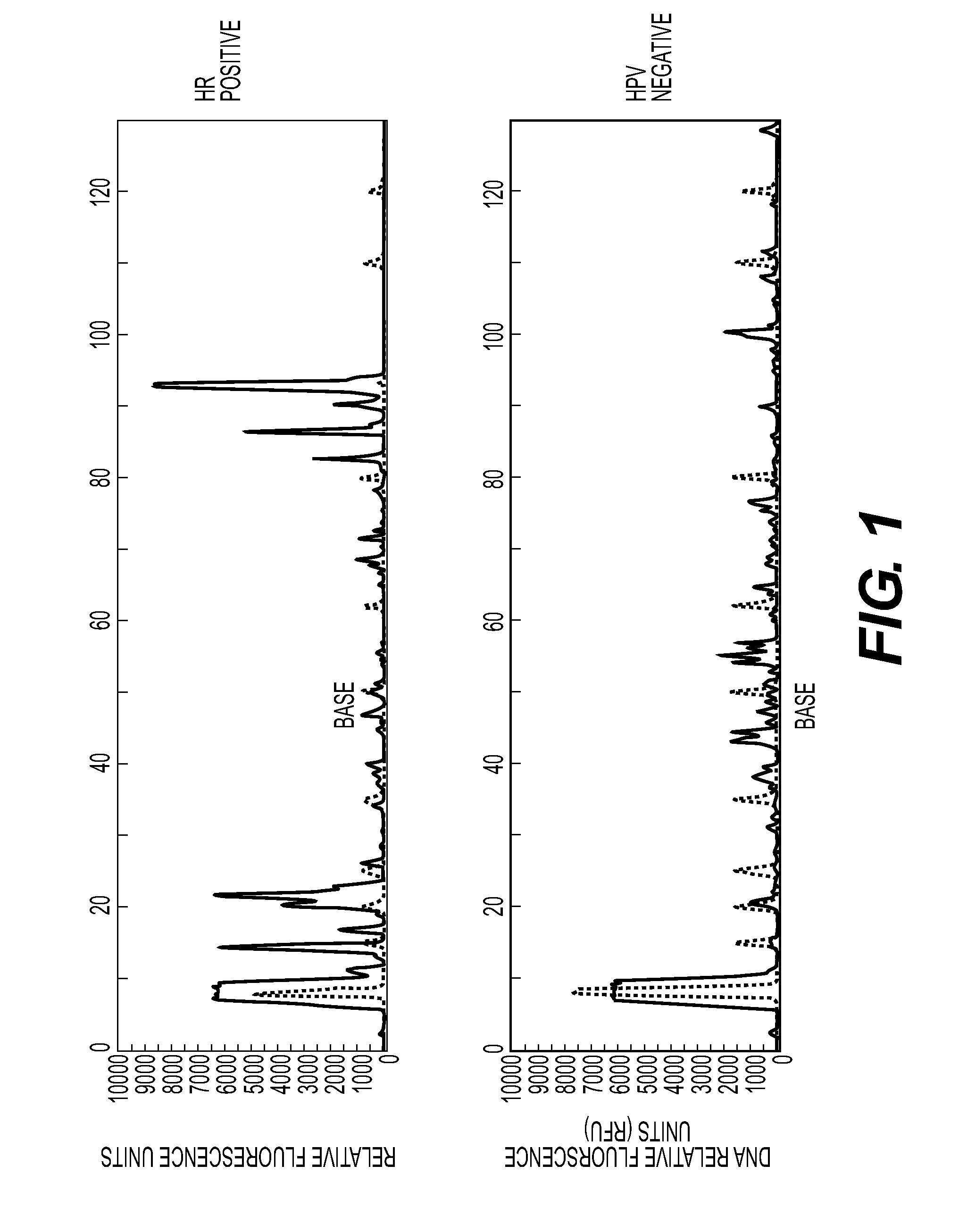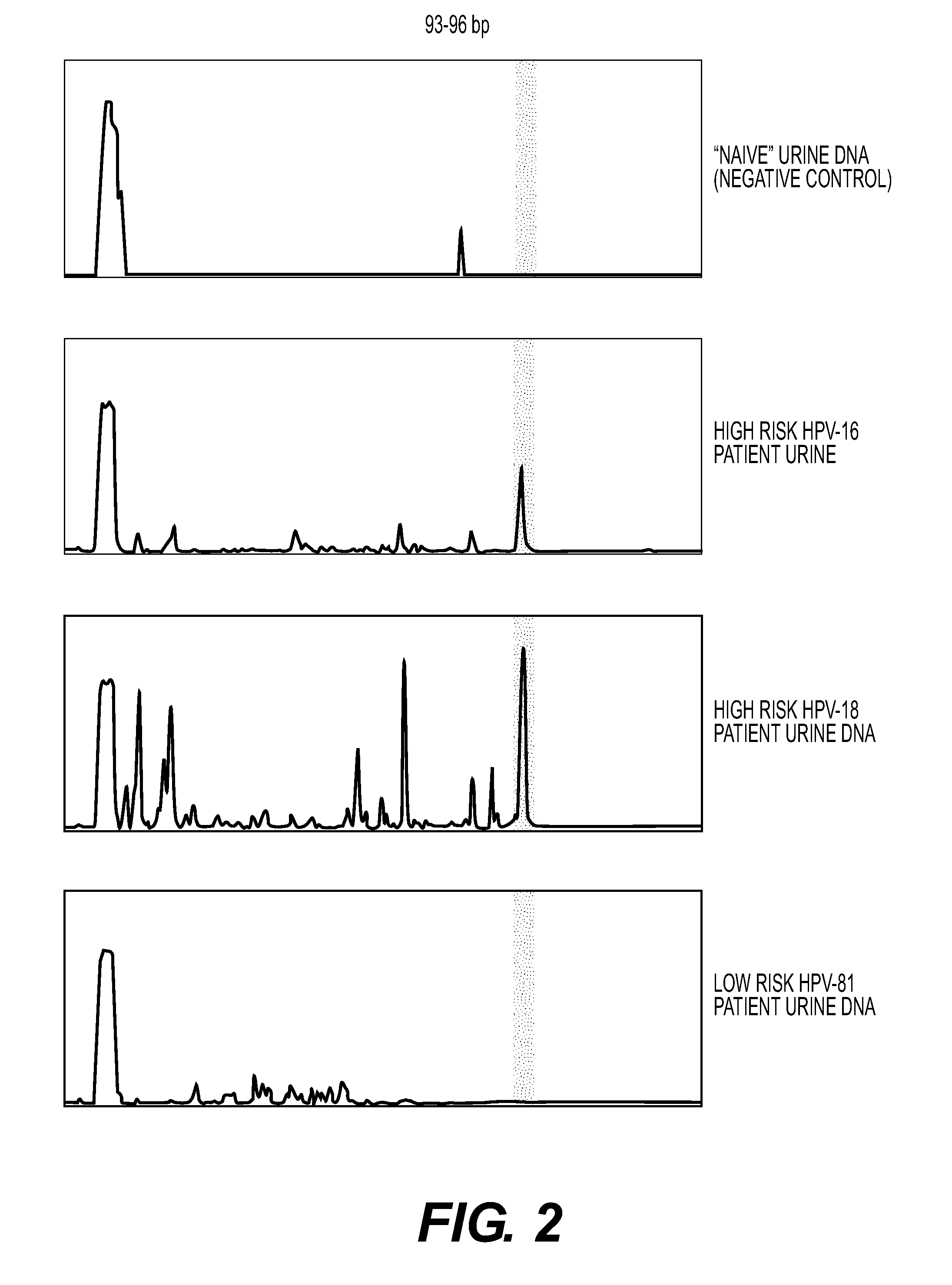HPV Detection in Urine
a technology of hpv and detection method, applied in combinational chemistry, biochemistry apparatus and processes, library screening, etc., can solve the problems of no processing of urine samples into cell-containing and cell-free fractions, or soluble and insoluble fractions
- Summary
- Abstract
- Description
- Claims
- Application Information
AI Technical Summary
Benefits of technology
Problems solved by technology
Method used
Image
Examples
example 1
Clinical Samples
[0081]154 urine samples were obtained from a cohort of women who were referred to a colposcopy clinic. The subjects were identified based on one or more abnormal Papanicolaou tests (Pap smears). The women were not pregnant, had not been treated previously for cervical intraepithelial neoplasia (CIN), and did not undergo a hysterectomy. The population of subjects was expected to have a high prevalence (˜80%) of HPV (all types).
[0082]The samples were treated with addition of EDTA to approximately 40-70 mM final concentration before storage at reduced temperature. Some samples were frozen while others were stored at about 4° C.
example 2
[0083]An aliquot of 500 μl of each urine sample was transferred to a tube. An equal amount of lysis buffer containing GITC (such as QIAGEN AL buffer) with about 11.2 μl / ml of carrier RNA is added to the sample followed by addition of an aliquot of protease. Proteolysis was allowed to proceed at approximately 56° C. for about 15 minutes. Ethanol (600 μl of 96-100%) was added for about 5 minutes at room temperature to enhance nucleic acid recovery.
[0084]The tube's contents were applied to a silica-based nucleic acid affinity column (such as the QIAmp MinElute column) and washed at least twice with ethanol rinses. Bound nucleic acids were eluted with 10 mM Tris, pH 8.0, optionally containing a preservative such as 0.04% azide.
example 3
Sample Analysis (HPV Detection)
[0085]Prepared nucleic acids from each sample were PCR amplified with a forward and reverse primer pair (SEQ ID Nos: 30 and 31) followed by capillary electrophoresis to detect the presence of an amplicon of 93-96 bp—the expected size of a high-risk HPV PCR product. FIG. 1 shows exemplary traces from a “positive” (HPV 16) sample and a “negative” (HPV 54) sample. Positive and negative refer to whether the primer pair is complementary to, and so would amplify, an HPV sequence and as confirmed by sequencing described below. The trace represents FAM-labeled products, including any amplified material from the forward primer and unincorporated forward primer (large peak at approximately 15 bp).
[0086]FIG. 2 shows exemplary traces from a negative control urine and two high risk urine samples (HPV 16 and 18) and one low risk sample (HPV 81). The identification of the HPV types was confirmed by sequencing as described below.
[0087]For fragment analysis, the instru...
PUM
| Property | Measurement | Unit |
|---|---|---|
| Fraction | aaaaa | aaaaa |
| Temperature | aaaaa | aaaaa |
| Concentration | aaaaa | aaaaa |
Abstract
Description
Claims
Application Information
 Login to View More
Login to View More - R&D
- Intellectual Property
- Life Sciences
- Materials
- Tech Scout
- Unparalleled Data Quality
- Higher Quality Content
- 60% Fewer Hallucinations
Browse by: Latest US Patents, China's latest patents, Technical Efficacy Thesaurus, Application Domain, Technology Topic, Popular Technical Reports.
© 2025 PatSnap. All rights reserved.Legal|Privacy policy|Modern Slavery Act Transparency Statement|Sitemap|About US| Contact US: help@patsnap.com


